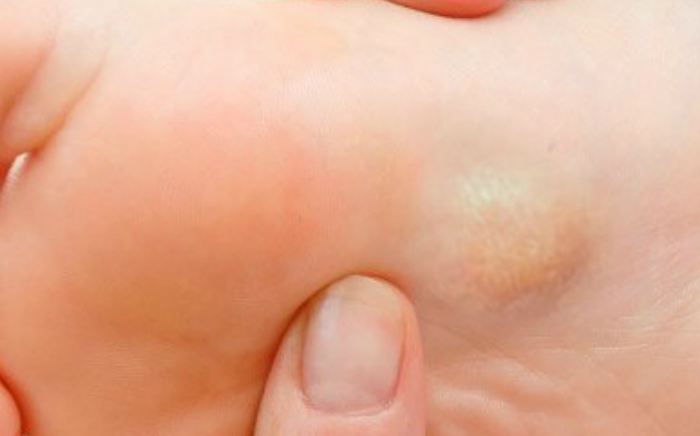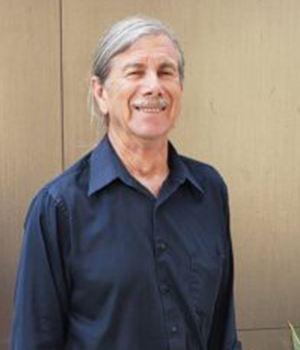Lumps and Bumps; Bottom of the Big Toe
A painful lump may be found on the bottom of the big toe. This condition often presents itself as a hard callused area. Sometimes a hard lump may be felt beneath the callused area. The most common cause of this condition is a limitation of movement of the big toe joint while walking. If there is limitation of movement at this joint, then the big toe cannot bend upward as the heel comes off the ground while walking. As a consequence, there is excessive force placed on the bottom of the big toe and an enlargement of the bone in this area will occur secondary to the pressure. Another cause is the presence of an extra bone or piece of cartilage in the area. However, it is the limitation of movement in the big toe joint that causes the area to become enlarged and painful.
People who have diabetes must watch these areas closely. Over time, the excessive pressure can cause this area to break down and ulcerate. One way to check to see if there is a limitation of movement of the big toe joint is to perform the following test. While standing on a flat surface, have another person try to bend the big toe upward. The joint that must move is the joint where the toe attaches to the foot. There is a joint in the middle of the big toe and this is not the one you are checking. If the big toe joint cannot be bent upward then a limitation of motion exists. Testing the movement at the joint without putting weight on the foot will give a false impression as to the available movement at the joint while you are walking. This limitation of movement of the big toe while walking can, over, time create an arthritic condition in the joint. A bony mass may then form on the top of this joint as a result of jamming in the joint. This condition is called hallux limitus or hallux rigidus. Treatment for the painful lesion in the bottom of the big toe joint consists of using functional foot orthosis to correct the functional limitation of the big toe joint motion or may consist of surgical correction of the hallux limitus. Rarely is surgery to remove only the lesion on the bottom of the toe alone, successful, because the cause of the initial problem still exists.

Lumps and Bumps in the Ball of the Foot
Painful lumps in the ball of the foot are usually but not always associated with a thickening of the skin or callus. These areas are due to the prominence of the long bone behind the toe called the metatarsal bone. When there is a mal-alignment of these bones, one or more of them may become propionate. When this occurs, the weight-bearing force across the bottom of the foot is disturbed. Weight is not evenly distributed across the ball of the foot, and these areas absorb greater pressure. The excessive pressure often forms a callus or thickening of the skin. People who have diabetes should watch these areas carefully. Over time, they can ulcerate the skin and can become infected. Treatment consists of removing the pressure with pads or using a molded insole or orthotic in the shoes.
Lumps and Bumps in the Arch of the Foot- Plantar Fibromas
Within the arch of the foot, firm, nodular masses may form. These can occur as a single mass or in clusters. They are called and are a non-cancerous tumor that forms within a ligament in the arch of the foot called the plantar fascia. Frequently, they will slowly enlarge causing pain while walking. Their cause cannot always be determined. Damage to the tendon will cause their occurrence and there is an association with taking the drug Dilantin. In 10% of the cases, patients will also demonstrate similar lumps in the palms of the hands called Dupuytren’s Contracture. Treatment consists of padding the area to reduce pressure. Functional foot orthotics will take the strain off of the plantar fascia ligament and sometimes cause the fibromas to shrink in size. Cortisone injections are of little value and may even stimulate the mass to enlarge or spread. Surgical excision of the mass requires the removal of most of the plantar fascia. Simple excision of the mass without removal of the entire ligament generally results in the recurrence of the mass. Whenever surgery is contemplated, the patient should wear a functional foot orthotic following the surgery. The orthotic helps to accommodate for the loss of the plantar fascia and its effect on foot function
Our Board Certified Podiatrists
Socal Foot and Ankle doctors are committed to delivering the most exceptional treatments.

Board Certified Foot & Ankle Specialist
Office Time
Location: Santa Monica
Mon – Thur: 9:00 AM – 5:00 PM
Friday: 9:00 AM – 5:00 PM
Location Marina Del Rey
Mon – Thur: 9:00 AM – 5:00 PM
Friday: 9:00 AM – 5:00 PM
Location: Cedars Sinai
Mon – Thur: 9:00 AM – 5:00 PM
Friday: 9:00 AM – 5:00 PM

Board Certified Foot & Ankle Specialist
Office Time
Location: Santa Monica
Mon – Thur: 9:00 AM – 5:00 PM
Friday: 9:00 AM – 5:00 PM

BOARD CERTIFIED
FOOT & ANKLE
Surgeons
- Comprehensive Treatment of Foot & Ankle Conditions in the Pediatric, Adult & Geriatric population
- 3 Practice Locations Santa Monica Medical Plaza, Cedars Sinai Medical Towers, & UCLA Health in Marina Del Rey
- On Staff with Providence Saint Johns Health Center &Cedars Sinai Medical Center
